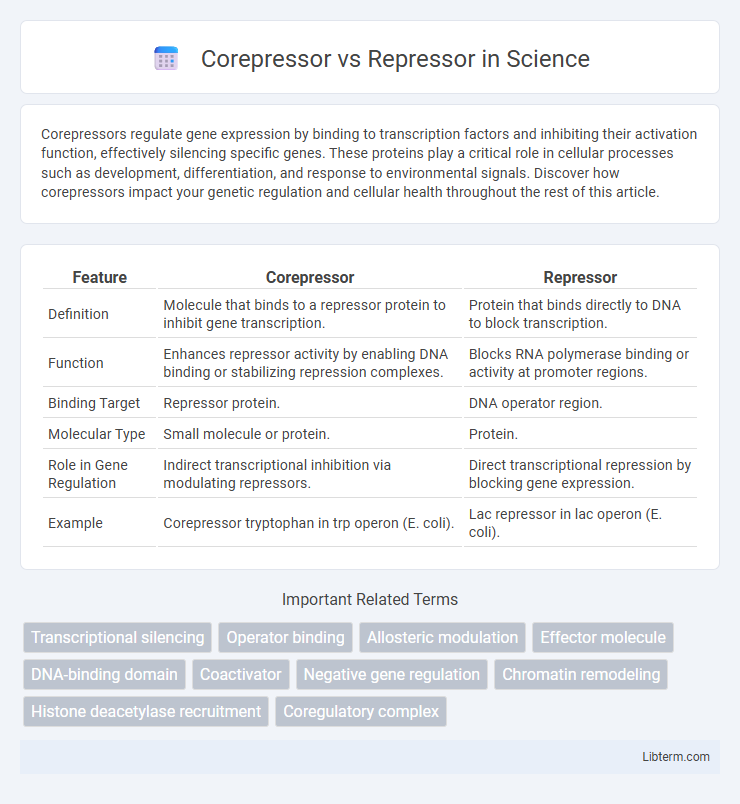Corepressors regulate gene expression by binding to transcription factors and inhibiting their activation function, effectively silencing specific genes. These proteins play a critical role in cellular processes such as development, differentiation, and response to environmental signals. Discover how corepressors impact your genetic regulation and cellular health throughout the rest of this article.
Table of Comparison
| Feature | Corepressor | Repressor |
|---|---|---|
| Definition | Molecule that binds to a repressor protein to inhibit gene transcription. | Protein that binds directly to DNA to block transcription. |
| Function | Enhances repressor activity by enabling DNA binding or stabilizing repression complexes. | Blocks RNA polymerase binding or activity at promoter regions. |
| Binding Target | Repressor protein. | DNA operator region. |
| Molecular Type | Small molecule or protein. | Protein. |
| Role in Gene Regulation | Indirect transcriptional inhibition via modulating repressors. | Direct transcriptional repression by blocking gene expression. |
| Example | Corepressor tryptophan in trp operon (E. coli). | Lac repressor in lac operon (E. coli). |
Introduction to Transcriptional Regulation
Corepressors and repressors both play crucial roles in transcriptional regulation by inhibiting gene expression, but they operate through different mechanisms. Repressors directly bind to specific DNA sequences, blocking RNA polymerase access to the promoter regions, while corepressors do not bind DNA themselves but interact with transcription factors to enhance repression. Understanding the distinction between these molecules is essential for elucidating complex gene regulatory networks in cellular processes.
What is a Repressor?
A repressor is a protein that binds to specific DNA sequences, known as operators, to inhibit gene transcription by blocking RNA polymerase from initiating transcription. Unlike corepressors, which are small molecules that assist repressors by binding to them to activate their DNA-binding ability, repressors themselves directly control gene expression by preventing transcription initiation. This mechanism is crucial for regulating metabolic pathways and maintaining cellular homeostasis.
What is a Corepressor?
A corepressor is a molecule that binds to a repressor protein, enhancing its ability to inhibit gene expression by facilitating the repressor's attachment to the operator region of DNA. Unlike a repressor that directly binds to DNA, a corepressor itself does not bind DNA but modulates transcription by enabling the repressor to block RNA polymerase activity effectively. Common examples of corepressors include tryptophan in the trp operon, which activates the repressor to halt transcription when tryptophan levels are high.
Mechanisms of Repression in Gene Expression
Corepressors inhibit gene expression by binding to repressors and modifying chromatin structure, typically through histone deacetylation, resulting in tighter DNA packaging and reduced transcription. Repressors directly bind to specific DNA sequences, such as operator regions, blocking RNA polymerase binding or elongation to prevent transcription initiation. Both mechanisms regulate gene expression but differ in their molecular targets: corepressors act as co-factors facilitating chromatin remodeling, while repressors function as sequence-specific DNA-binding proteins.
Corepressor vs Repressor: Key Differences
Corepressors and repressors both regulate gene expression by inhibiting transcription, but corepressors do not directly bind DNA; instead, they interact with DNA-bound repressors to enhance repression. Repressors function by binding specific DNA sequences, blocking RNA polymerase or transcription factors, whereas corepressors modify chromatin structure or recruit histone deacetylases to silence genes. The key difference lies in the mode of action: repressors directly bind DNA to prevent transcription initiation, while corepressors act as cofactors modulating repressor activity and chromatin state.
Role of Repressors in Cellular Processes
Repressors function by binding to specific DNA sequences, blocking RNA polymerase attachment or progression, thereby inhibiting gene transcription crucial for cellular regulation. Corepressors do not bind DNA directly but associate with repressors or transcription factors to enhance repression, modifying chromatin structure for gene silencing. The dynamic interplay between repressors and corepressors controls gene expression patterns essential for cell differentiation, development, and response to environmental signals.
Role of Corepressors in Gene Silencing
Corepressors function by binding to transcription factors, facilitating gene silencing without directly interacting with DNA, unlike repressors that attach directly to operator regions to inhibit transcription. They recruit histone deacetylases and other chromatin remodeling enzymes, leading to chromatin condensation and transcriptional repression. This mechanism is crucial for regulating developmental genes and maintaining cellular identity by modulating gene expression epigenetically.
Examples of Repressors and Corepressors
Repressors such as LacI in E. coli bind directly to DNA, inhibiting transcription initiation by blocking RNA polymerase access to the promoter. Corepressors like the tryptophan-activated Trp repressor complex do not bind DNA alone but instead require a small molecule corepressor to induce conformational changes that enable DNA binding and transcriptional repression. These distinct mechanisms highlight that repressors act by direct DNA interaction, while corepressors modulate repressor activity through non-DNA molecules to control gene expression.
Corepressor-Repressor Interactions
Corepressors enhance repressor function by binding to them and facilitating the recruitment of histone deacetylases, leading to chromatin condensation and gene silencing. This interaction is crucial for transcriptional repression in various cellular processes, as corepressors lack DNA-binding domains and depend on repressors to target specific gene promoters. The dynamic corepressor-repressor complexes modulate gene expression patterns by altering chromatin structure and blocking the assembly of the transcriptional machinery.
Biological Significance and Applications
Corepressors and repressors play crucial roles in gene regulation, with repressors directly binding to DNA sequences to inhibit transcription, while corepressors do not bind DNA but interact with repressors or other transcription factors to enhance gene silencing. Corepressors like NCoR and SMRT recruit histone deacetylases to modify chromatin structure, leading to a more condensed and transcriptionally inactive state, which is essential for regulating developmental processes and cellular differentiation. These molecular mechanisms have significant applications in disease treatment, such as targeting corepressor complexes in cancer therapy to reactivate silenced tumor suppressor genes or modulating repressor activity in metabolic disorders.
Corepressor Infographic

 libterm.com
libterm.com